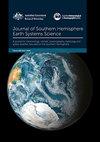Meteorological drivers of the eastern Victorian Black Summer (2019–2020) fires
IF 3.6
4区 地球科学
Q1 Earth and Planetary Sciences
引用次数: 1
Abstract
The spring and summer of 2019–2020 (Black Summer) saw the largest and most significant bushfire outbreak recorded in eastern Australia. In Victoria, the fires ran from mid-November through early autumn. In this paper, we use a high-spatial and temporal resolution 48-year fire weather re-analysis data set (VicClim5) to describe fire weather and vertical wind and stability profiles for five significant high Forest Fire Danger Index (FFDI) fire events and compare these with detailed fire reconstructions. A feature of several of these fires was very active overnight fire spread driven by topographically enhanced low-level jets and low fine fuel moisture content. The FFDI values on these nights were either the highest or near highest on record in the 48-year data set. We describe cases of lightning ignition, prefrontal fire spread and two cases of post-frontal fire spread – one into Mallacoota on the early morning of 31 December 2019 and the other a northward overnight run down the Buffalo Valley on 4–5 January 2020. On two of the days studied there were complex wind changes associated with the inland penetration of low-level south-easterly winds under the influence of locally generated pressure gradients. An elevated hot, dry mixed layer above these shallow layers also played an important role. On one occasion there is some evidence of possible mountain-wave modulation of surface wind flows. These events demonstrate a range of features of the fire weather and climate in eastern Victoria and the utility of VicClim5 in 3-dimensional climatological analyses.东维多利亚黑夏(2019-2020)火灾的气象驱动因素
2019-2020年春夏(黑夏)是澳大利亚东部有史以来规模最大、影响最严重的森林大火爆发。在维多利亚州,大火从11月中旬持续到初秋。在本文中,我们使用高时空分辨率的48年火灾天气再分析数据集(VicClim5)来描述5个显著的高森林火灾危险指数(FFDI)火灾事件的火灾天气、垂直风和稳定性特征,并将其与详细的火灾重建结果进行比较。其中几起火灾的一个特点是夜间非常活跃,火灾蔓延是由地形增强的低空射流和低细燃料水分含量驱动的。这些夜晚的FFDI值是48年数据集记录中最高或接近最高的。我们描述了闪电点火、锋面前部火势蔓延和两个锋面后火势蔓延的案例——一个是在2019年12月31日凌晨进入马拉库塔,另一个是在2020年1月4日至5日夜间向北蔓延至布法罗山谷。在研究的两天中,在当地产生的压力梯度的影响下,出现了与低空东南风向内陆渗透有关的复杂风变化。在这些浅层之上的高温干燥混合层也发挥了重要作用。有一次,有一些证据表明山波可能对地面气流进行调制。这些事件展示了维多利亚东部火灾天气和气候的一系列特征,以及VicClim5在三维气候分析中的应用。
本文章由计算机程序翻译,如有差异,请以英文原文为准。
求助全文
约1分钟内获得全文
求助全文
来源期刊

Journal of Southern Hemisphere Earth Systems Science
Earth and Planetary Sciences-Oceanography
CiteScore
8.10
自引率
8.30%
发文量
0
审稿时长
>12 weeks
期刊介绍:
The Journal of Southern Hemisphere Earth Systems Science (JSHESS) publishes broad areas of research with a distinct emphasis on the Southern Hemisphere. The scope of the Journal encompasses the study of the mean state, variability and change of the atmosphere, oceans, and land surface, including the cryosphere, from hemispheric to regional scales.
general circulation of the atmosphere and oceans,
climate change and variability ,
climate impacts,
climate modelling ,
past change in the climate system including palaeoclimate variability,
atmospheric dynamics,
synoptic meteorology,
mesoscale meteorology and severe weather,
tropical meteorology,
observation systems,
remote sensing of atmospheric, oceanic and land surface processes,
weather, climate and ocean prediction,
atmospheric and oceanic composition and chemistry,
physical oceanography,
air‐sea interactions,
coastal zone processes,
hydrology,
cryosphere‐atmosphere interactions,
land surface‐atmosphere interactions,
space weather, including impacts and mitigation on technology,
ionospheric, magnetospheric, auroral and space physics,
data assimilation applied to the above subject areas .
Authors are encouraged to contact the Editor for specific advice on whether the subject matter of a proposed submission is appropriate for the Journal of Southern Hemisphere Earth Systems Science.
 求助内容:
求助内容: 应助结果提醒方式:
应助结果提醒方式:


